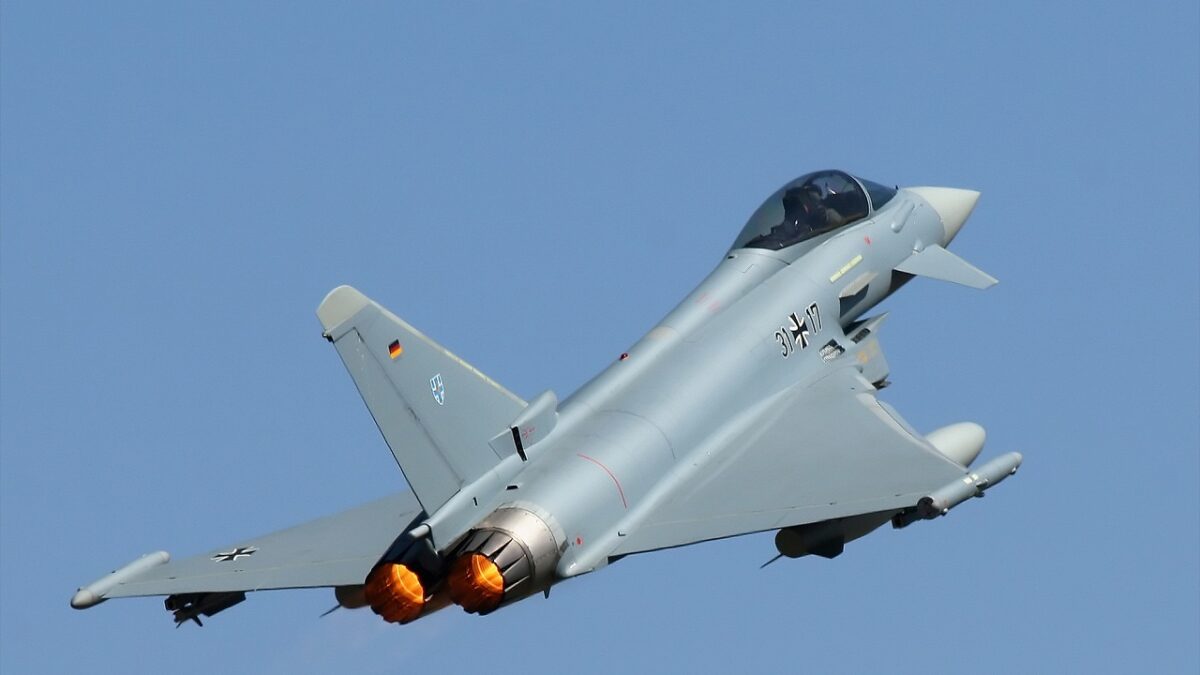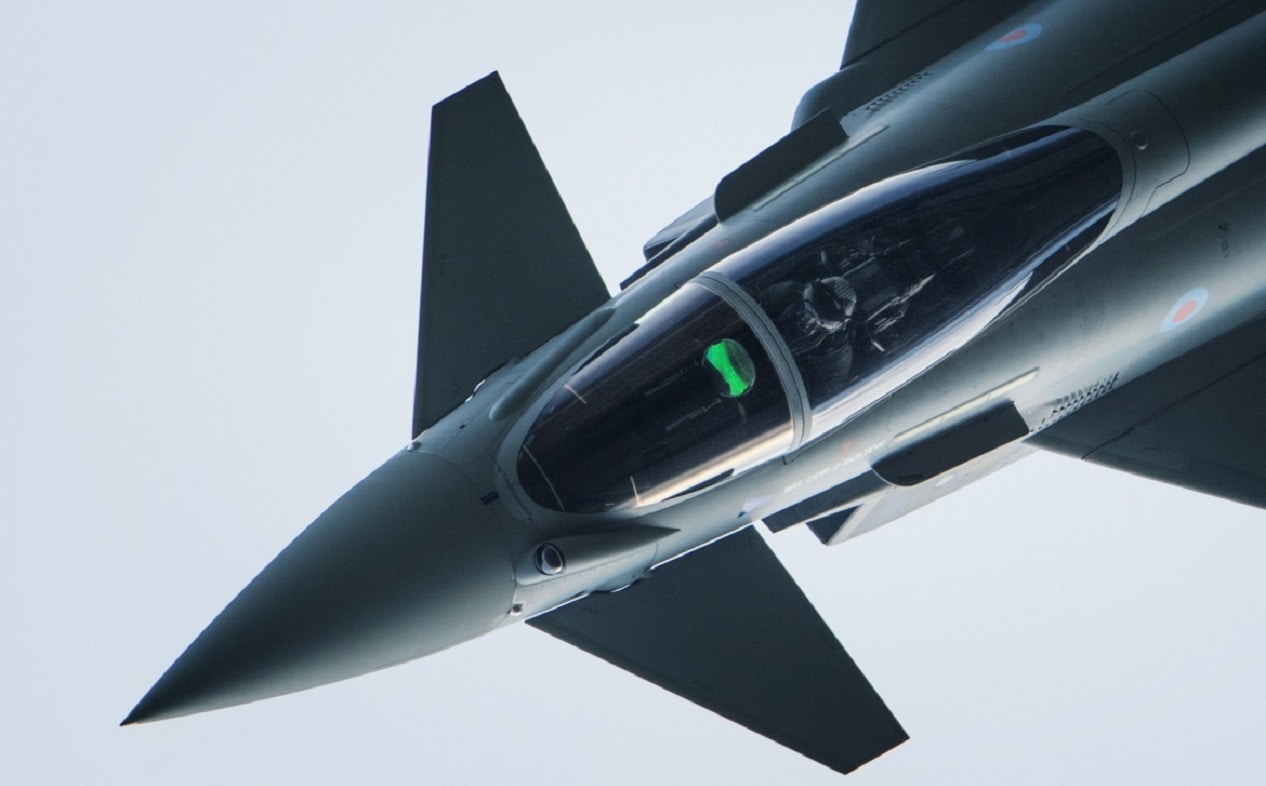The Qatar Armed Forces procured its first Eurofighter Typhoon aircraft this week, representing the latest milestone in the United Kingdom-Qatar relationship. Doha’s $5 billion program to acquire Eurofighter jets and Hawk advanced jet trainers came to fruition during a roll-out ceremony at BAE Systems’ Warton Aerodrome in the United Kingdom.
The first fighter will ferry to Qatar later in the month and will be followed by 23 additional Typhoons that the country has ordered from BAE Systems. Doha also ordered 9 Hawk jet trainers. As a collaborative product by several European countries, the Typhoon has remained one of the most versatile and successful multi-role fighters in the skies.
The Eurofighter Typhoon was Part of the European Fighter Aircraft Program
In 1983, the development of the Eurofighter Typhoon commenced alongside the Future European Fighter Aircraft program (FEFA). This multinational collaborative body was comprised of the UK, Germany, France, Italy and Spain. Two decades earlier, Germany, Italy, and the UK created the Panavia Tornado, a powerful twin-engine variable-sweep wing airframe designed to fend off the Soviet Union.
While the Panavia ultimately saw conflict in the Gulf War, Iraq War, and Kosovo War, its European operators desired an even more formidable airframe. The Typhoon was the answer. By the time the first airframe was produced in the early 1990’s, however, the Cold War had ended, culminating in the downfall of the Soviet Union. The interest and urgency that drove the development of the fighter seemed almost obsolete. Despite this, the European countries saw the roll-out of the Eurofighter Typhoon through.
The Eurofighter Typhoon Still Flying High
The Typhoon is a highly agile fighter both at supersonic and low speeds, thanks to its relaxed stability design. As detailed by Harrison Kass in 19FortyFive, “To compensate for the jet’s inherent instability, a quadruplex fly-by-wire control system was installed – as a pilot’s manual operation would not have been able to keep the jet stable. The fly-by-wire system prevents the pilot from pushing beyond the permitted maneuvering envelope.”
Kass also noted that “While the Eurofighter Typhoon is not a stealth fighter, efforts were taken to reduce the jet’s radar cross section (RCS). For example, the Typhoon has inlets that conceal the front of the engines. And many of the jet’s flight surfaces, like the leading edges of the wing, canard, and rudder, are swept to reduce the RCS. Some of the jet’s weaponry is mounted partially recessed into the aircraft, reducing the RCS further. The partially recessed weapons payload is something of a half-measure relative to the fully internal weapons bays found on fifth-generation stealth fighters.”
Equipped with advanced and unique attributes, the Typhoon was quickly exported and remains operational in the service of seven nations today. Germany, Italy, Spain, the UK, Austria, Saudi Arabia, and Oman all fly Eurofighter Typhoons, making Qatar the latest country to procure this airframe.
Doha signed on to acquire the Typhoons in 2017, closely following the country’s purchase of 36 Boeing F-15 Qatar Advanced-variant Eagles from the U.S. and 24 Dassault Rafale fighter jets from France. Doha’s decision to invest in such a diverse range of airframes was likely due to its increasingly isolated position at the time.
In 2017, the United Arab Emirates (UAE), Bahrain, Saudi Arabia, and Egypt cut ties with Qatar due primarily to Doha’s support for the Muslim Brotherhood, its relationship with Iran, and links to terrorism. The Gulf Cooperation Council (GCC) members “came up with a list of 13 demands that included shutting down all of Qatar’s regional news outlets, cutting links to any political figures in the region, and pulling back from ties with Iran and Turkey.
Many of the complaints about Qatar go back decades, and Qatar has periodically promised its neighbors it would moderate its actions. Regional concerns increased when Qatar developed close ties with Islamist political groups during the Arab Spring, according to the Center for Strategic and International Studies. However, by 2021 the Gulf leaders ended their rift with Doha following the signing of the Al-Ula Declaration “solidarity and stability act.”
While Doha is no longer isolated from its Gulf peers, the upcoming arrival of 24 Eurofighter Typhoons symbolizes its strengthening relationship with the UK.

German Air Force Eurofighter. Image Credit: Creative Commons.
What the Experts Told Us: Love Eurofighter Typhoon, But Would Really Love F-35s
A retired Qatari military officer explained to us why these Eurofighter Typhoon jets are so important to Doha: “While they are not F-35s nor do they have stealth capability – something we want very badly – the Eurofighter Typhoon offers some very impressive capabilities that our Air Force needs. We need every top-tier fighter we can get. The Eurofighter Typhoon is a great acquisition for our air force and we surely will put it to good use. However, in the future, stealth must be a part of our next fighter purchase. Maybe the F-35 could be possible at some point.”
Expert Biography: Maya Carlin is a Middle East Defense Editor with 19FortyFive. She is also an analyst with the Center for Security Policy and a former Anna Sobol Levy Fellow at IDC Herzliya in Israel. She has by-lines in many publications, including The National Interest, Jerusalem Post, and Times of Israel.

